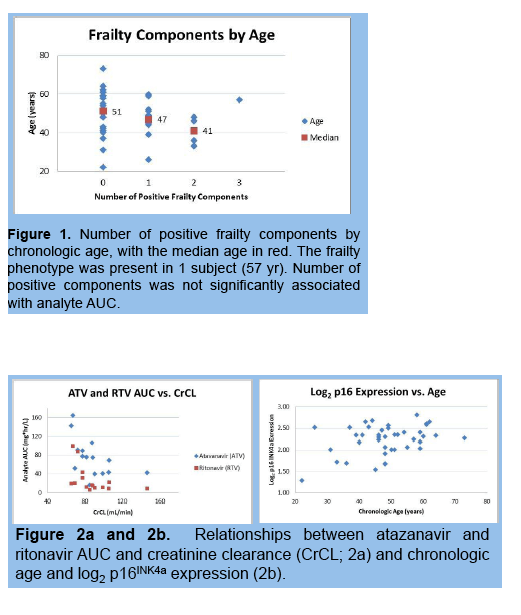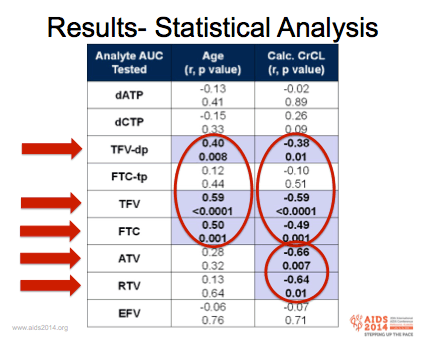 |
 |
 |
| |
Tenofovir(TFV), Emtricitabine(FTC), Intracellular Metabolite, and Endogenous Nucleotide (EN) Concentrations as a Function of Aging in HIV+ Subjects
|
| |
| |
Reported by Jules Levin
20th International AIDS Conference, 20-25 July, 2014, Melbourne, Australia
Julie B. Dumond1, Christine R. Trezza1, Owen Francis2, Heather M.A. Prince3, Katie Mollan4, Mackenzie Cottrell1, Craig Sykes1,
Chad Torrice4,Nicole White1, Stephanie Malone1, Ruili Wang1, Kristine B. Patterson3, Alan Forrest5,
Michael G. Hudgens2, Norman E. Sharpless4, Angela D.M. Kashuba1,3 Schools of Pharmacy1,
Global Public Health2, Medicine3 and Lineberger Comprehensive Cancer Center4,
UNC-CH; School of Pharmacy, SUNY Buffalo5, USA

--------------------------------
[from Jules: an important question is the safety and efficacy of ARTs in older patients, say over 60, will drug levels increase, will there be additional safety concerns, and so which ARTs might be safer or less safe; further studies are needed to understand if with aging ART drug AUC, levels, increase with age & if kidney function will decrease further in HIV+ individuals vs HIV-neg individuals on certain ARTs & if this leads increased risk]
---------------------------------------


TFV-dp is tenofovir diphosphate, the active intracellular metabolite of tenofovir, and dATP is the endogenous nucleotide that competes with TFV-dp for incorporation into HIV DNA by reverse transcriptase, i.e. the natural base that makes up DNA. If dATP gets incorporated into the DNA, viral replication continues, if the TFV-dp gets incorporated, then replication stops. FTC-tp is the intracellular metabolite of emtricitabine, and dCTP is its natural competitor.





We conducted a clinical pharmacokinetic, or PK, study that collected 4 samples from HIV-positive subjects. This is an interim analysis of 43 subjects, all receiving a tenofovir/emtricitabine backbone, with 28 receiving efavirenz, and 15 receiving boosted atazanavir. To address our hypothesis, which is that age alone is not a predictor of PK changes in older patients, we performed Fried frailty phenotyping and p16INK4a expression analysis. P16 is a tumor suppressor gene and marker of cellular aging. We then calculated area under the curve, or AUC, for tenofovir, emtricitabine, their intracellular metabolites, the endogenous nucleotides dATP and dCTP, as well as efavirenz, atazanavir, and ritonavir, and used statistical measures to test for associations between AUC and subject characteristics, frailty components and p16 expression. At the time of abstract submission, efavirenz, atazanavir, and ritonavir concentrations were not available, but I will present those results to you today. As a secondary objective, we also report endogenous nucleotide concentrations, and their ratios to the intracellular metabolites of tenofovir and emtricitabine in PBMC samples. Evidence suggests these metabolite:endogenous nucleotide ratios are important for efficacy, but the target values are not fully established. We investigated this here, as nucleotide pools may be affected by disease state and inflammation, and to determine the ratios in a sample of HIV-positive adults.

Full demographic details are available on the poster, but these 43 subjects range in age from 22 to 73 years, with a median age of 48 years. 18 of them have at least one positive component of the Fried frailty phenotype, with 1 subject meeting the definition of frailty. The AUC values for each analyte were comparable to literature values, bearing in mind that these AUCs were constructed from 4 samples rather than dense PK sampling. Here are results of the statistical analysis, showing the association with age and creatinine clearance for each analyte. The top number is the Spearman rho, indicating the strength and direction of the association, and the lower number is the p-value. Significant p-values at the 0.05 level are highlighted. We did not adjust for multiple comparisons. We observed an association between tenofovir diphosphate, tenofovir, and emtricitabine AUC with age, and also with creatinine clearance. The Spearman rho values are similar in magnitude but opposite in direction, for example the rho for tenofovir and age is 0.59, while for tenofovir and creatinine clearance, it is -0.59. Because age and creatinine clearance themselves are related, from this analysis we cannot definitively say which factor is driving the association, but plan to explore this further. We also observed an unexpected association between atazanavir and ritonavir AUC with creatinine clearance, which we will continue to explore with data from 10 additional subjects and in multivariate analyses. We did not observe associations between number of positive frailty components or p16 expression with analyte AUC.

And for our secondary objective, these are the median and interquartile range concentrations of tenofovir diphosphate and dATP, the endogenous nucleotide it competes with for action, and their concentration ratio, as well as emtricitabine triphosphate and its endogenous competitor, dCTP, and their concentration ratio. The TFV-dp and FTC-tp concentrations are similar to what we and others have previously observed, at 98.7 and 3864 fmol/million cells, respectively. The median dATP concentration is 115 fmol/million cells, giving a TFV-dp:dATP ratio of 0.89. The median dCTP concentrations is 331 fmol/million cells, giving a FTC-tp:dCTP ratio of 11. In the statistical analysis, the boosted atazanavir regimen was significantly associated with higher dATP AUCS, and no associations with other variables were noted. We will continue to explore and refine this analysis when cytokine results for the full data set are available.

|
| |
|
 |
 |
|
|